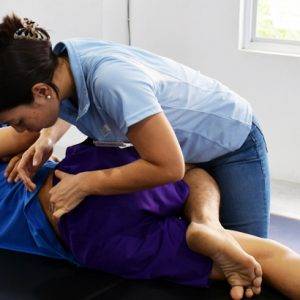The term ‘chiropractic’, derived from Greek roots to mean ‘done by hand’, originated with Daniel David Palmer and was coined by a patient, Reverend Samuel H. Weed. Chiropractic is a healthcare profession that focuses primarily on the brain-body connection, especially the relationship between the spine and nervous system. Basically, for the brain to understand what is going on and for it to be able to respond appropriately and function optimally; there must not be any interference to the information travelling all around the body via our nervous system. The nervous system (particularly the spinal cord and spinal nerves) is protected by the spine. Hence, any areas of dysfunction in the spinal joints may create an interruption to the normal communication between the nervous system and body. These imbalances/interferences prevent the proper flow of information along the nerves, therefore preventing the brain from responding appropriately. Chiropractic is a fast-growing profession and is now practised worldwide, including in Malaysia. Chiropractic forms the world’s third-largest regulated healthcare profession and is one of the most commonly utilised alternatives to medical care. Chiropractic is well-regulated by law in over 40 international jurisdictions, such as the United States of America, United Kingdom, Australia, New Zealand, South Africa, Hong Kong, Philippines, and Thailand. As a healthcare service, chiropractic offers a conservative and cost-effective management approach for neuromusculoskeletal disorders. The World Health Organization (WHO) encourages and supports countries in the proper use of safe and effective medication, products, and practices in national health services. In 2005, WHO developed a guideline on basic training and safety in chiropractic practice.
| Malaysian Regulations |
|---|
| In Malaysia, chiropractic is classified under the Malaysian Traditional and Complementary Medicine (T&CM) Division which was formed in 2004 by the Malaysian Ministry of Health. On 11 January 2006, Traditional and Complementary Medicine Units were created in the Malaysian Ministry of Health facilities (e.g. government hospitals) to implement the integration of traditional and complementary medicine within the national healthcare system. The Traditional and Complementary Medicine Act 2016 (Act 775) was gazetted on March 10, 2016, and enforced on August 01, 2016. Following the enforcement of Act 775, the Traditional and Complementary Medicine Council was formed on January 16, 2017, to regulate the practice of traditional and complementary medicine services in Malaysia. With the recommendation from the Traditional and Complementary Medicine Council, the Malaysian Minister of Health has recognised chiropractic as a recognised practice area under Act 775 on 01 August, 2017. In the recent revision of the Fees (Medical) (Amendment) Order 2017 under the Fee Act 1951 [Act 209], chiropractic service in the public hospital fee structure was included. On 01 March, 2021, Phase 2 of Act 775 has been enforced and started the process of licensing for T&CM Practitioner including chiropractic practitioners. The Malaysian Ministry of Health also define Chiropractic as a primary health care profession concerned with the diagnosis, treatment and prevention of disorders of the neuromusculoskeletal system and the effects of these disorders on general health. There is an emphasis on manual techniques, including spinal adjustment and/or joint and soft tissue manipulation with a particular focus on improving joint dysfunction, reducing pain and disability and promoting rehabilitation. |
Chiropractic education is regulated by the Councils on Chiropractic Education International (CCEI), which has accrediting bodies for different regions in the world. The chiropractic educational programme is a minimum of four years. All accredited programmes provide a curriculum incorporating elements of basic sciences (e.g. physiology, anatomy and biochemistry), clinical sciences (e.g. laboratory diagnosis, radiographic diagnosis, orthopaedics, neurology, and nutrition), and clinical intern experience. In the clinical arena, chiropractic students have limited training in pharmacology and critical care but they have significant training in clinical biomechanics, neuromusculoskeletal diagnosis, manual therapy, nutrition and exercise rehabilitation.
| About IMU’s Chiropractic Programme |
|---|
| The International Medical University‘s (IMU) Chiropractic Programme is accredited by the prestigious Council on Chiropractic Education Australasia (CCEA) and the Malaysian Qualification Agency (MQA). It is only accredited Chiropractic programme in Southeast Asia. IMU Chiropractic Programme is a 4-year programme including academic and clinical training. Students also have the option of transferring to one of our partner universities, namely RMIT University in Australia, AECC University College, or the University of South Wales in the United Kingdom for completion of their degree after studying the first few years of their degree at IMU. Currently, our alumni are practicing in few countries, including New Zealand, Australia, Hong Kong, and Shanghai, etc. |










Ree
What are the qualifications for admission to Australia?
IMU News
Hi Ree,
We have forwarded your enquiry to the enquiry team.
They will reach out to you soon.
Alternatively, you may choose these alternative platforms to reach out to us during business hours Mondays to Fridays, 8.30am – 5.30pm (excluding Public Holidays):
Call us at: 603- 2731 7272
Email us at: [email protected]
Chat with us at: http://www.imu.edu.my